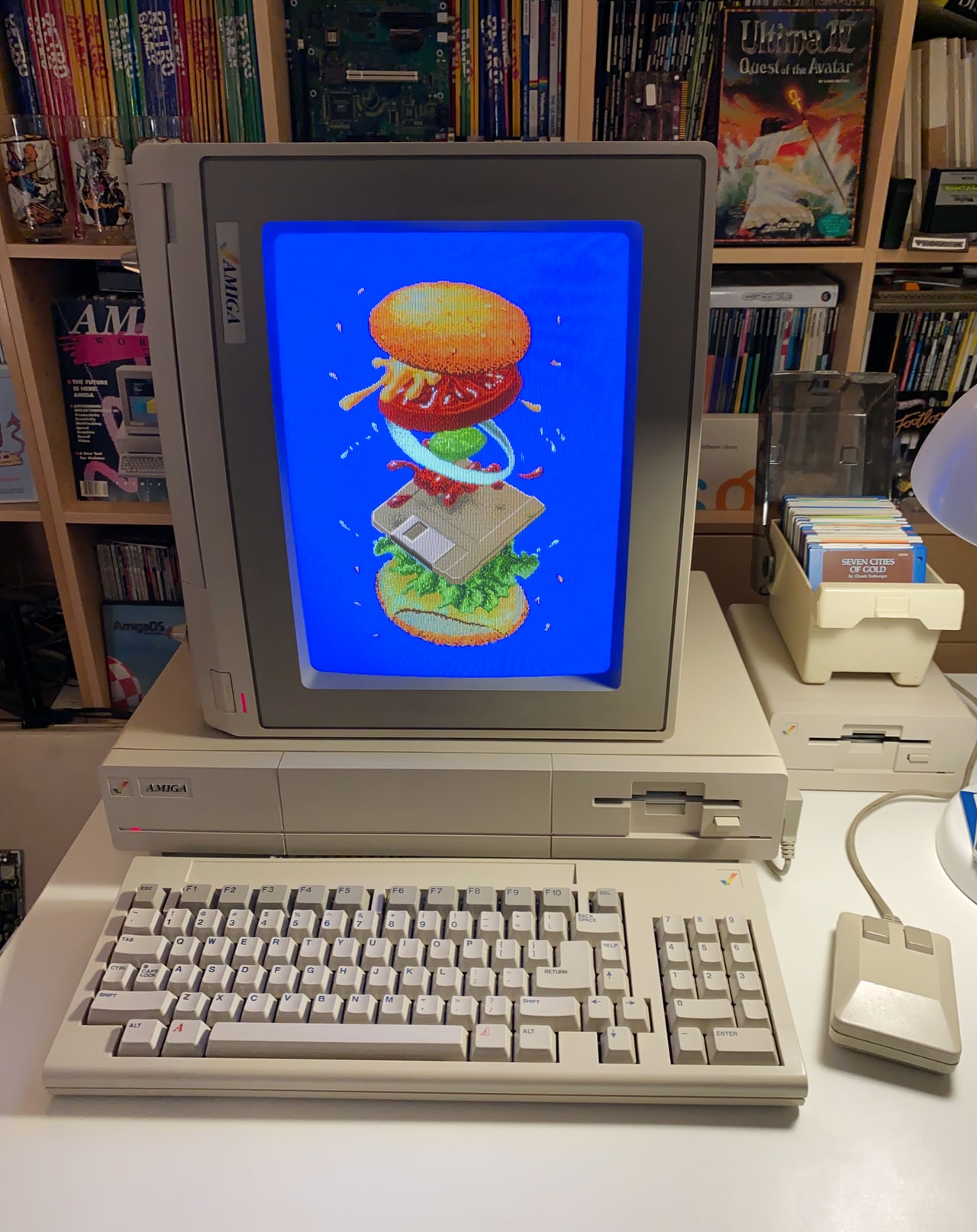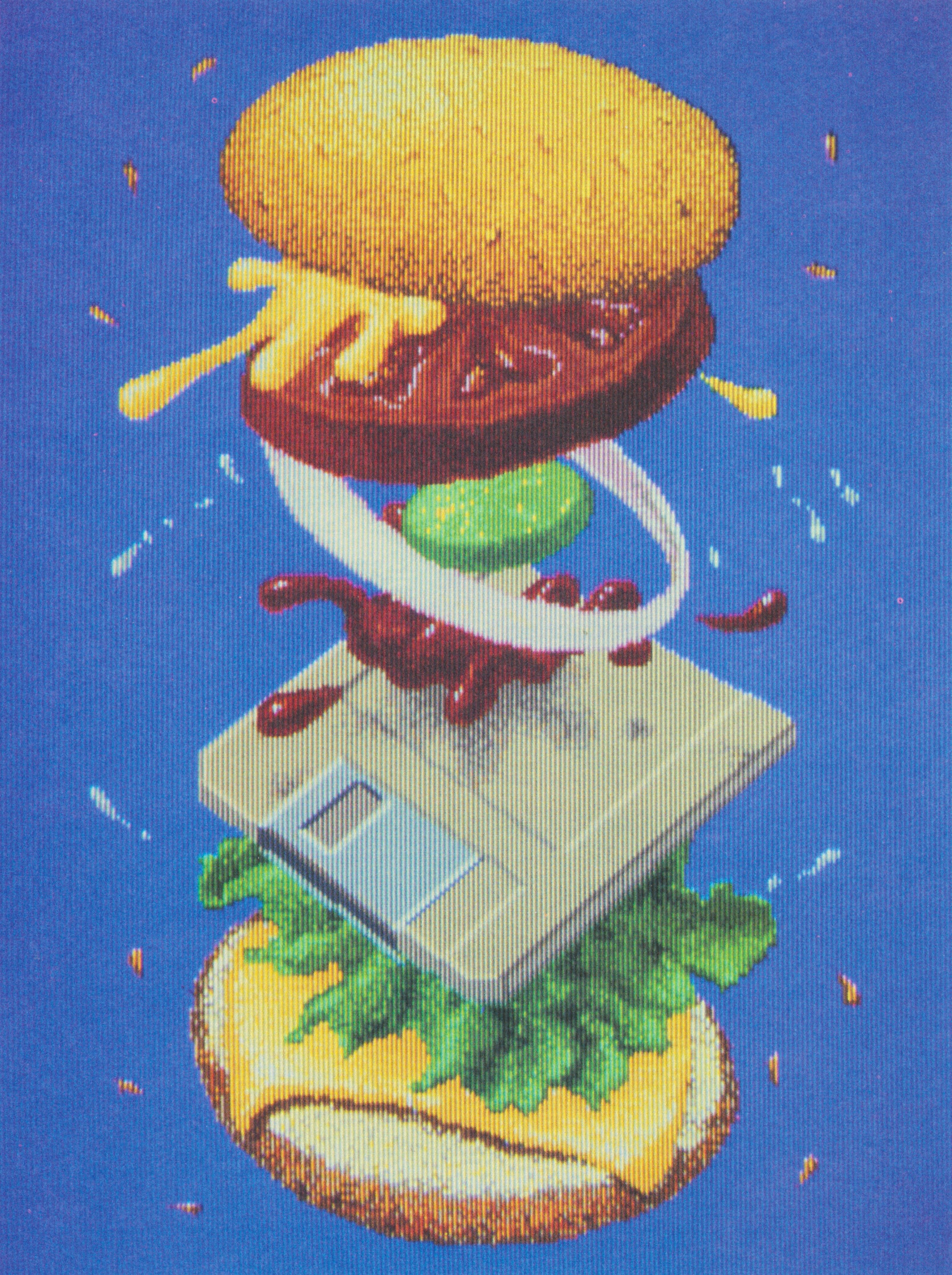
It was in the late summer of 1985 when I first heard of the Amiga. I learned about the forthcoming system in an issue of Personal Computing magazine that featured the Amiga on its cover and contained an in-depth dive into the what was the most amazing computer — by an incredible margin — I had ever seen. The specifications I read and the photos I saw within made such an impact on me that I wrote a post to this blog about the magazine itself, A Look at the Sauciest Magazine I Ever Owned, about ten years ago.
The magazine’s deep dive into the Amiga (take a look for yourself) featured various examples of graphics created on the system, the most impressive of which — to my eye — was entitled “Four-Byte Burger,” a whimsical and lovely, exploded digital painting of a floppy-disk cheeseburger of sorts created by Jack Haeger, Director of Amiga’s Art and Graphics Department at the time. The 32-color image utilized the Amiga’s 4096-color palette to produce graphics the likes of which I had never seen before. (At the time, I was using an Apple II that was 6-colors only, basically.) A short time later the premier issue of AmigaWorld magazine appeared on the shelf, also featuring the image within, and finally after the launch of the system, “Four-Byte Burger” made its way to the inner covers of the Graphicraft paint program’s user manual which is the source of the high-res scan I was able to secure a few years back.
Around the time of that earlier post, I tried to track down a digital copy of the image, but to no avail. It wasn’t in the Amiga Graphics Archive, or seemingly anywhere else I looked. I came to find out that “Four-Byte Burger,” along with several other early Amiga paintings featured in these magazines, were created with a version of Graphicraft so early in development that it did not yet feature file I/O capabilities. These images were drawn, the CRT display was photographed, and then those lovely pixels were cast into the void when power was taken from system RAM with the flick of a switch.
These images, in digital form at least, were lost to time…like tears in rain.
Luckily, I wasn’t the only one that had been carrying that image around in his head for the past 40 years or so. Stuart Brown, YouTuber XboxAhoy who is renowned in gamer circles, recently posted to his video game documentary channel a video in which he laments the loss of this memorable image and sets out to recreate it based on the photographs we have available. This digital restoration was an arduous process, and it is fully documented by the benevolent restorer in his video. And, in the end, I believe he achieved his goal. The results bring an enormous smile to my face.
Once I watched this amazing video, I immediately knew that I had to get this piece of digital artistry that’s so beloved to me onto the glowing phosphor screen of my Amiga 1000. Ahoy was kind enough to provide a link to the resulting Amiga IFF image file when asked, so I loaded it onto the Parceiro device’s SD card and after waiting for the 1080 monitor to degauss post-rotation (I encountered the same obscured color due to the Earth’s magnetic field that he did in his video), I beheld an incredible sight indeed: an Amiga 1000 displaying its very best image — and on my desk — in the Byte Cellar.
Thanks, Ahoy.


Love the article and the Bladerunner reference. :) I had no idea the Amiga was 4096 colors when the best PCs had at the time were 256–what an awesome machine the Amiga was. Too bad it couldn’t save Commodore.
Thanks!
You know, VGA with its 18-bit (262,144 colors) palette and 256-color-onscreen MCGA mode didn’t arrive until 1987 with the IBM PS/2. When the Amiga landed in 1985, the best consumer graphics around came from EGA that followed the PC/AT. EGA offered at most 16 colors on-screen from a palette of 64.
This PC landscape of the era makes the Amiga seem even more impressive, I think. The Amiga could display 32-colors on-screen from its 4096 color palette with the launch chipset, as well as all 4096 colors at once with its unusual HAM (Hold-And-Modify) mode. (Very shortly after launch, the original chipset was modified to introduce the 64-color EHB (Extra Half-Brite) mode, where you had a palette of 32 selectable colors plus 32 others that were half the intensity of those.)
(It’s interesting to note that the 8-bit Atari 400 and 800 home computers, with chipsets designed by Amiga chipset designer Jay Miner year before, featured 256-color palettes since 1981.)
Yep, no doubt the Amiga was impressive. Even the C64 with it’s sound support blew away PC sound until the sound cards arrived.
I still remember the Atari computers now that you mention it. It was confusing time to buy a computer as there wasn’t universal compatibility for any formats, or even the basic that was built-into most computers. The reason we went with a C64 versus others was the disk drives vs tape drives since tape load times were so much longer than disk. And today’s kids get mad when something doesn’t happen instantly! I’d like to have them load a document and program from a tape drive to learn some lessons.
Pingback: Tower 57 – When is an Amiga game not an Amiga game? – Games From The Black Hole
Which monitor is that? Did you paint the picture in portrait mode or just turn it by 90 degrees? Looks good!